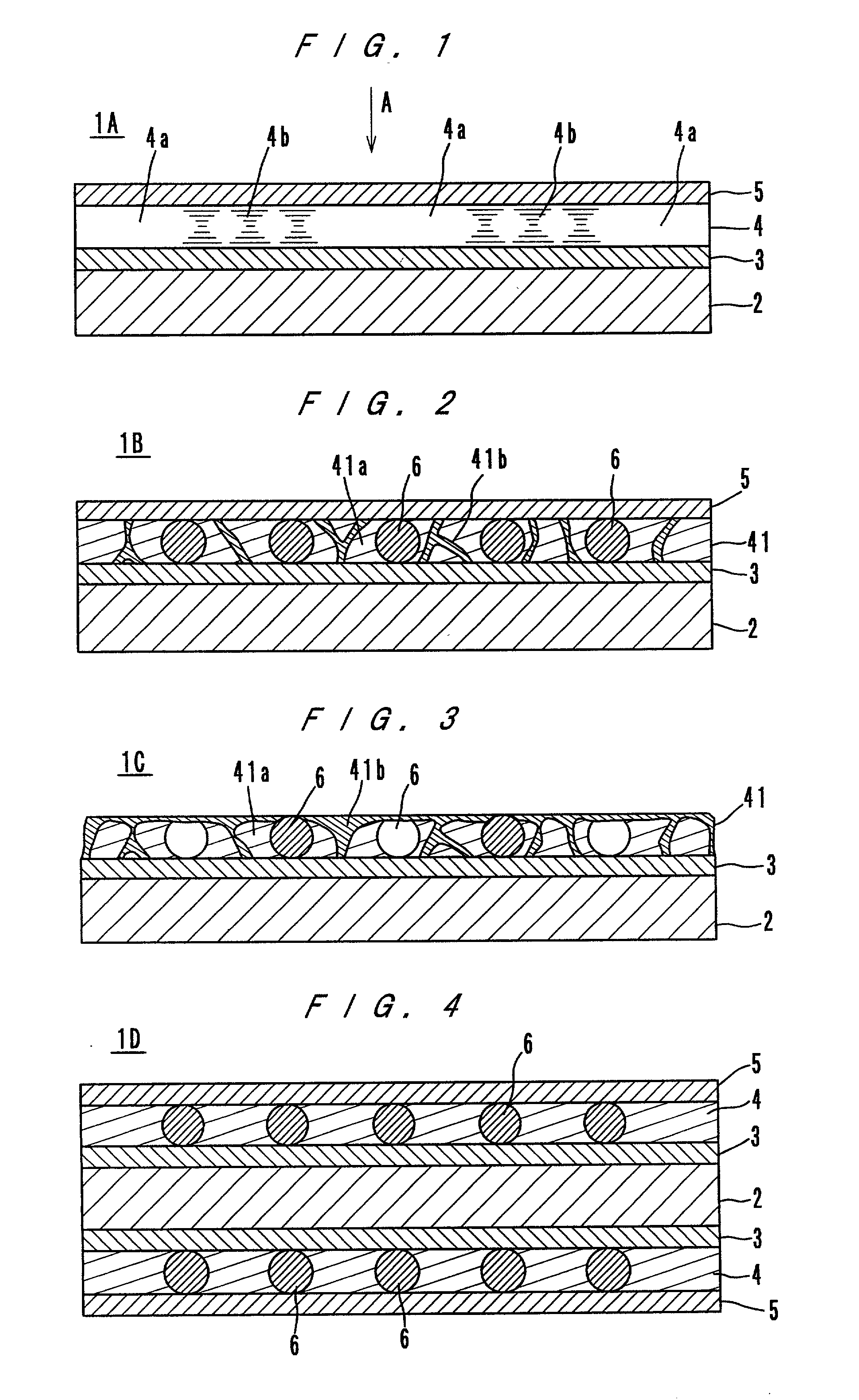Image bearing medium
a bearing medium and image technology, applied in the field of image bearing mediums, can solve the problems of large stumbling block to practical applications, inability to develop full colors for desired images, and high cost of ohp sheets compared with copy sheets,
- Summary
- Abstract
- Description
- Claims
- Application Information
AI Technical Summary
Benefits of technology
Problems solved by technology
Method used
Image
Examples
second embodiment
[0064] Second Example of the Second Embodiment
[0065] A polyimide solution (made by Sumitomo Bakelite Co., Ltd.) was coated on a white PES (polyether sulfone) film and was dried and thermally set to be made into an intermediate layer 3 with a thickness of 1 .mu.m. Silica spacers 6 having an average particle size of 15 .mu.m were dispersed in ethanol and sprayed on the intermediate layer 3. Then, the liquid crystal mixture having the composition described in the first example was coated on the intermediate layer 3, and a transparent PET (polyethylene tetephthalate) film with a thickness of 2 .mu.m was superposed thereon as a protective layer 5.
[0066] Then, while the protective layer 5 was pressed, ultraviolet rays of 15 mW / cm.sup.2 were radiated for five minutes. Thus, a composite layer (recording layer 41) with a thickness of 15 .mu.m was formed.
third embodiment
; See FIG. 3
[0067] In a rewritable thermosensible recording medium 1C according to the third embodiment shown in FIG. 3, the protective layer 5 of the recording medium 1B shown in FIG. 2 is omitted. Therefore, the fabrication process thereof is simplified, and the production cost can be reduced. Even in the absence of the protective layer 5, the resin layer 41b formed on the surface of the recording layer 41 functions as a protective layer. Therefore, the recording layer 41 has a sufficient mechanical strength, and damage due to an external force such as bend or friction can be minimized. Also, the low molecular cholesteric liquid crystal compound, even if heated to the temperature at which it assumes an isotropic phase, is not much deteriorated.
[0068] Specific examples of the materials and the fabrication method will be described below.
[0069] First Example of the Third Embodiment
[0070] Polyvinyl alcohol was dissolved in water at a ratio by weight of 1 to 31, and carbon black was di...
fourth embodiment
; See FIG. 4
[0074] A rewritable thermosensible recording medium 1D according to the fourth embodiment shown in FIG. 4 is so constructed that the intermediate layer 3, the recording layer 4 and the protective layer 5 are formed on the front and back surfaces of the base layer 2. Information can be displayed on both surfaces of this recording medium 1D.
[0075] Specifically, aluminum with a thickness of about 600 .ANG. was provided as an intermediate layer 3 for reflecting light on both sides of a transparent PES (polyether sulfone) film with a thickness of 200 .mu.m. The liquid crystal compound of the chemical formula (A) and toluene were mixed and dissolved with each other at a ratio by weight of 10 to 100, and silica spacers 6 having an average particle size of 15 .mu.m were mixed in this solution. The resulting solution was coated by a blade on the intermediate layer 3 and was heated and dried to be made into a rewritable thermosensible recording layer 4 with a thickness of 20 .mu.m...
PUM
| Property | Measurement | Unit |
|---|---|---|
| thickness | aaaaa | aaaaa |
| thickness | aaaaa | aaaaa |
| thickness | aaaaa | aaaaa |
Abstract
Description
Claims
Application Information
 Login to View More
Login to View More - R&D
- Intellectual Property
- Life Sciences
- Materials
- Tech Scout
- Unparalleled Data Quality
- Higher Quality Content
- 60% Fewer Hallucinations
Browse by: Latest US Patents, China's latest patents, Technical Efficacy Thesaurus, Application Domain, Technology Topic, Popular Technical Reports.
© 2025 PatSnap. All rights reserved.Legal|Privacy policy|Modern Slavery Act Transparency Statement|Sitemap|About US| Contact US: help@patsnap.com



